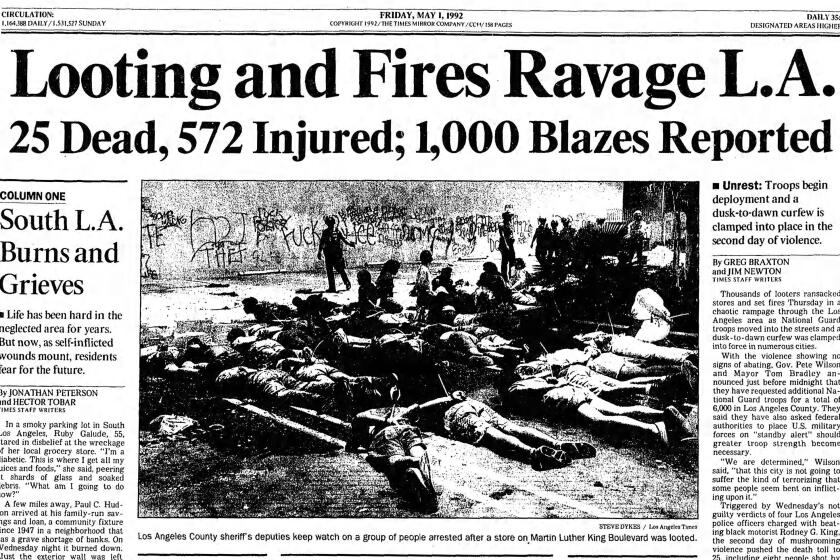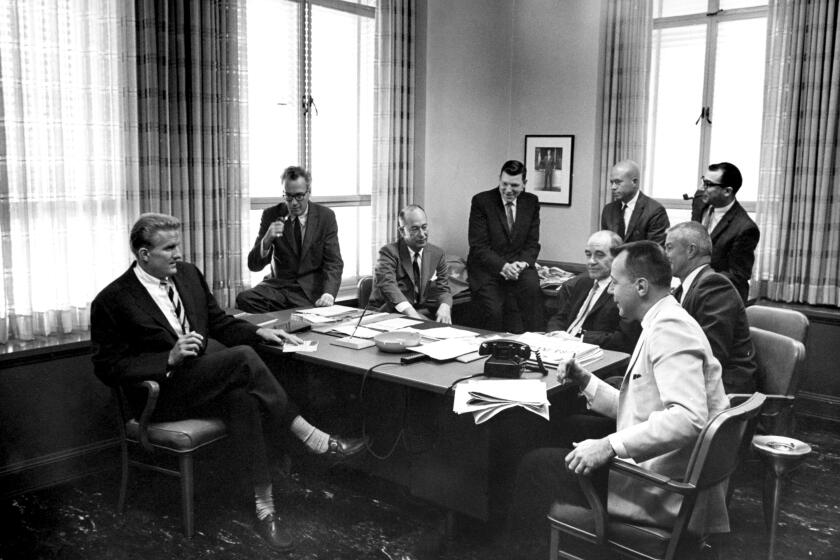- Share via
We were in bedrooms, home offices, kitchens, even backyards. In ties and sweats and T-shirts and blouses. Some of us were already friends; most of us knew of each other only as bylines until we logged onto the Zoom call and saw everyone’s faces. This was the first meeting of the Los Angeles Times Guild’s Latino Caucus, and it happened just a few months ago, when we were already well into the COVID-19 pandemic.
Members banded together this summer in the spirit of our Black colleagues, who earlier had organized their own caucus to demand equity and representation from a paper that had long failed them in both categories. Our situation, in many ways, was even more complicated.
Over the last 139 years, Los Angeles Times readers have seen in their newspaper the best and worst of how the American media have covered Latinos.
This paper used to freely call Mexicans “wetbacks,” “border jumpers” and “greasers.” The paper advocated for the invasion of Latin American countries to protect U.S. interests, wholeheartedly embraced ruthless dictators and, in 1934, upon news of his assassination, described slain Nicaraguan rebel leader Augusto Sandino, to whom the Sandinistas paid tribute with their name, as a “little jungle warrior.”
The paper’s coverage of Latinos and Latin America mostly reflected the times. But The Times’ unique rancor sparked scholarly articles, angry boycotts and letters to the editor over decades.
Our reckoning with racism
As the country grapples with the role of systemic racism, The Times has committed to examining its past. This project looks at our treatment of people of color — outside and inside the newsroom — throughout our nearly 139-year history.
When I announced on Facebook in late 2018 that I was joining The Times, more than a few friends announced they would finally subscribe. When I asked what took them so long, they listed enough examples of anti-Latino Times coverage, real and perceived, to fill a full page.
Yet despite this disturbing record, Latinos at the Los Angeles Times have also helped to change American journalism for the better.
The paper was home to Ruben Salazar, whose columns explained the Chicano movement to the nation until he was killed by a tear gas projectile fired by a sheriff’s deputy while covering a protest in East Los Angeles on Aug. 29, 1970.
It ran a series titled simply “Latinos,” which won the 1984 Pulitzer Prize for public service and taught news organizations to pay more attention to the changing demographics in their communities. It brought to the mainstream the issue of unaccompanied Central American minors in the United States with the 2003 series “Enrique’s Journey,” which also won a Pulitzer Prize and became a bestselling book.
Today, Latinos at the paper are writers, columnists, designers, social media managers and editors. But there are not enough of us. In a city that’s almost 50% Latino, only 13% of the newsroom is Latino. In a state where Latinos are a plurality, only 11% of Times editors and managers are Latino. Too many of us leave for other jobs, frustrated at the lack of opportunities here.
And that’s why about 30 of us hopped on Zoom for the initial Latino Caucus meeting. No one knew what to expect. Would it lead to tangible change or turn into an unproductive vent fest? The tone was evident as we introduced ourselves.
Smiles. Optimism. Determination.
I was amazed that so many of us turned out, in all the variations of the Latino prism. There were immigrants and third-generation Chicanos. Mexican Americans and Central Americans and Caribbeans and South Americans. Old and young, veterans and newcomers like myself.
•••
It’s hard to imagine what the early owners of the Los Angeles Times would have made of the gathering. Often these days, whenever one of my Latino colleagues does something great, I like to tweet out “Harrison Gray Otis is rolling in his grave.” In their newspaper with a Spanglish name, members of the Otis and Chandler families that ran the company for 118 years made little effort to understand big swaths of the city. When Latinos — especially Mexicans — made the paper’s pages, they tended to be either romanticized or demonized, sometimes in the same stories.
The Times “had a westward-ho type of attitude,” said Felix Gutierrez, professor emeritus of journalism at USC. “This was a conquered territory, and Mexicans were conquered people. The elites were seen as cultured but good people whose best days were past. The rest were seen as half-breeds and shiftless.”
The dichotomy was there from the start. An 1883 story about northern Mexico’s “greasers” with the subhead “What They Are and How They Live” strove to distinguish for readers the difference between Mexicans with mixed heritage and those who were supposedly of pure Spanish blood. The latter were described as “bright, active and intelligent.”
Greasers, on the other hand, were “lazy, thriftless, ignorant, superstitious and unstable,” living in homes that bore “the stamp of negligence and shiftlessness.” Because they raised only enough on their land to feed themselves, the article said, “between their villages there are large tracts of unoccupied lands subject to entry, which are being rapidly occupied by Americans.”
Among those acquiring that land were the Chandlers, who held ranches in northern Mexico and Baja California that eventually totaled hundreds of thousands of acres.
Back home, they helped to propagate what historians call California’s Spanish-fantasy heritage, celebrating the state’s mission past as romantic and carefree. The Times cemented this myth in historical remembrances, serialized fiction and news stories about society events where L.A.’s new white ruling class — including the Chandlers — dressed as the dons and señoritas of yore. Meanwhile, the city’s actual Mexican residents were written about largely in crime stories or what Gutierrez called “zoo pieces” — stories about Latinos not as individuals but as members of an ethnic group with little chance of being more than that.
Things got even worse with the advent of the Mexican Revolution in the 1910s. Editorial cartoons that once depicted Mexicans as quaint, if backward, now featured dark-skinned, big-lipped rebels. President Wilson was regularly bashed for not trying to invade Mexico, and even local Latino institutions came under attack.
“Watch the dirty Mexican newspapers in this town,” snarled a Nov. 28, 1919, column. “They ought to be suppressed.”
The rhetoric was so bad during that era that Canadian professor Mark Cronlund Anderson deemed The Times “the most unrepentantly racist in its portrayals of Mexico and Mexicans” in a 2000 study of how the American media depicted Pancho Villa.
One 1915 editorial titled “What about Mexico” declared that “no land under the sun is blessed with greater agricultural, mineral and timber resources. No land under the sun is cursed with a more idle, dishonest, bloodthirsty lot of savages for people.” Another editorial from the same year proclaimed that “the Spanish blood which came into [Mexico] with Cortez was itself a mixture of Iberian, Roman, Celtic, Vandal, Goth and Semitic, and this, mixed with the Indians in the proportion of one to five, produced a people that developed the baser qualities of both races.”
“It was unrelenting,” Anderson said. “You’d think that living in Southern California, since you’re more likely to see Latinos on a daily basis, that [The Times’ racism] would lessen, but situations like that sometimes create people that are frequently the ones that hate [racial minorities] the most.”
There were attempts at improving the coverage as Mexican refugees, most from the more Catholic and conservative regions of the country, streamed into the Southland after the revolution. From 1921 to 1933, The Times published a daily column of local and international news in Spanish “for the benefit of the many Spanish-speaking friends of The Times and the many students of the tongue in Los Angeles,” according to the inaugural column. Coverage of Mexican food was always kind, even groundbreaking, as Mexican Americans told their own stories and shared their unadulterated recipes with an eager gringo audience.
Think pieces with titles such as “Why it’s Hard for Mexicans to Become Americans” examined why Mexican youth in this country seemed so alienated from mainstream society as they assimilated. But the paper couldn’t resist quoting a Catholic priest who said that, for many, their “invariable end is the juvenile court.”
A low point of The Times’ Latino coverage was the summer of 1943, when American military men assaulted Mexican Americans while the police looked on in what became known as the Zoot Suit Riots. The Times openly wished for the beatings in the months leading up to the attacks, and it cheered when they finally happened — “Zoot Suiters Learn Lesson in Fight with Servicemen,” read one front-page headline.
First Lady Eleanor Roosevelt suggested that the violence against zoot suiters may have been prompted by “long-standing discrimination against the Mexicans,” something The Times hotly disputed, saying her critique bore “an amazing similarity to the Communist Party line propaganda.”
“We have bragged of our Spanish and Mexican missions,” it continued, with no sense of irony. “We have paid homage and honor to the Californians of Mexican descent among us…. We like Mexicans and we think they like us.”
Years later, a 1956 American Journal of Sociology study found that The Times’ coverage of the Zoot Suit Riots “gave sanction to making the Mexican the victims of widespread hostile crowd behavior.”
By then, Otis Chandler — the great-grandson of Los Angeles Times scion Harrison Gray Otis — was preparing to bring his family’s paper into modernity. But Latinos had to wait a couple more decades.
William J. Drummond, a pioneering Black reporter for the paper and longtime professor at the UC Berkeley Graduate School of Journalism, remembered how assistant editors in the late 1960s would speak in exaggerated Mexican accents during news meetings and crack insensitive jokes, like the one that the definition of “Brown Power” was a “poor Mexican pushing a jalopy.”
New slurs took the place of “greasers” and “banditos” in the paper — “wetbacks” in the 1950s and 1960s, “illegal aliens” in the 1970s. As refugees began to arrive in large numbers from Central America, stories increasingly became alarmist: In 1978, when The Times launched a yearlong series about how immigrants were transforming Southern California, the lead article’s headline was “Illegal Aliens are Winning Beachhead for Third World.”
The following year, Editor William F. Thomas — credited with executing Chandler’s vision for a world-class newspaper — told the Columbia Journalism Review, “We can’t seem to bring in qualified minorities who can step in and compete with the high-quality reporters we already have.”
“It was a really, really white world,” Drummond said. “But slowly but surely, it began to change.”
•••
I was familiar with the anti-Latino history of the Los Angeles Times before I joined as a staff writer. It didn’t bother me, because that’s not The Times of today.
The fact that I, a child of two Mexican immigrants — one of whom came to this country in the trunk of a Chevy — am able to write this critique, get edited by another son of mexicanos and hear feedback from a higher-ranking Chicano editor, shows how far removed we are from those ugly days. And yet here we are. It seems Latinos in the Los Angeles Times newsroom band together every decade to push for change … and then the next generation has to do it again.
This time around, the Latino Caucus penned an open letter to Times owner Dr. Patrick Soon-Shiong with specific demands. The core ones were for the paper to hire more Latinos to better reflect Los Angeles, offer an apology for “fomenting episodes of anti-Latino hysteria in California and the United States,” and finally put our stories and reporters at the center instead of treating us as an eternal minority.
Such asks might seem like woke nonsense — litigating the past when we should be content with our present. Yet no less a figure than Harry Chandler — grandfather to Otis, and someone so intent on bending Mexicans to his will that he tried to convince the Taft administration to annex his family’s ranch in Baja California and was once arrested for his role in an attempted coup in the Mexican state — had words relevant to our cause.
“A people that has lost touch with its historical past, forgotten its traditions and wasted its heritage is as unfortunate as a man who has lost his memory,” he wrote in 1933, in promoting the then-new Olvera Street. “Without knowledge of the past, both the present and the future are meaningless.”
We as a news organization must acknowledge our dark past to move forward. You as readers need to know it, to see how much we’ve improved. I remember a meeting last year between Latino leaders and masthead editors. The former blasted The Times for not covering Latino issues enough; the latter had to gently let them know that the paper had, in fact, covered some of the very issues we were accused of ignoring. It was obvious those leaders hadn’t read us in a good while.
And we in the Latino Caucus should study our employer’s anti-Latino history, not only to ensure we never allow a repeat of those embarrassments but also to learn about how the pioneers before us pushed the paper to change.
The first, of course, was Salazar, who created a template from nothing on how to cover Mexican Americans before he was struck down (The Times had hired only a handful of Latinos before him). Following in his path was Frank del Olmo, a Times intern whom Salazar convinced to stay at the paper instead of joining him at KMEX-TV Channel 34, where Salazar also worked.
In a 1995 column, Del Olmo shared what Salazar once told him: that The Times “had an obligation to report on Latinos … so that Anglo society would better understand the barrio and its problems.”
He and others pushed to publish the “Latinos” series despite the skepticism of white colleagues, some of whom openly mocked the effort; one, according to longtime Metro editor Frank O. Sotomayor, asked whether project members would write their “stories in spray paint.” Alumni of that group joined a staffwide revolt in 1994 when The Times endorsed the reelection of California Gov. Pete Wilson, who had spent the year pushing for the passage of the anti-immigrant Proposition 187.
Del Olmo penned a furious dissent and became the first Latino on The Times masthead in its aftermath (there are none today). When the Chandlers sold The Times and its parent company to Tribune in 2000, Del Olmo concluded his column on the news with: “They won’t be missed in the Latino community. Let them leave. Or, as folks say in the barrio: Que se vayan.”
Over the decades, starting with Salazar, the paper’s Latinos have pushed for change and seen progress, including the so-called Latino Initiative, a 1998 effort that sought to seed Latinos and Latino coverage through all parts of the paper.
But again and again, the efforts sputtered because editors couldn’t get their minds around planning for a mañana in Southern California when Latinos would dominate the civic and cultural life of the region.
Mañana is now.
More to Read
A cure for the common opinion
Get thought-provoking perspectives with our weekly newsletter.
You may occasionally receive promotional content from the Los Angeles Times.








